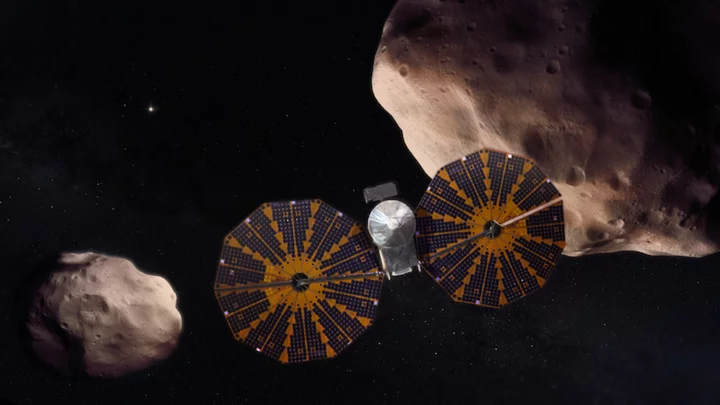As NASA's Lucy probe sped by the asteroid Dinkinesh at 10,000 mph, mission scientists spotted a surprise: This asteroid was actually two asteroids.
The space agency found that a smaller space rock some 720 feet across (220 meters) orbited the half-mile wide (790 meters across) Dinkinesh. Or so it appeared. Now, upon closer inspection, they've realized that smaller asteroid is actually two asteroids.
"As NASA’s Lucy spacecraft continued to return data of its first asteroid encounter on Nov. 1, 2023, the team was surprised to discover that Dinkinesh’s unanticipated satellite is, itself, a contact binary — that is, it is made of two smaller objects touching each other," NASA wrote in an update.
SEE ALSO: NASA spacecraft keeps on going faster and faster and fasterIn the image below, snapped from 1,010 miles (1,630 km) away, you can see Dinkinesh on the left and the intriguing contact binary on the right.
The half-mile-wide asteroid Dinkinesh on the left and the intriguing contact binary on the right. Credit: NASA / Goddard / SwRI / Johns Hopkins APLThe Lucy mission is en route to the mysterious and never-explored Trojan asteroids — trapped in two swarms around Jupiter and thought to be pristinely preserved building blocks of planets. The mission's first target is now known to be three asteroids. It's a target that mission planners wanted to visit before reaching the Trojans, to test the spacecraft's crucial abilities to track these distant objects at blazing speeds.
This is the first contact binary asteroid planetary scientists have ever spotted in orbit around another space rock.
"We haven’t seen many up close, and we’ve never seen one orbiting another asteroid," John Spencer, the mission's deputy project scientist at the Southwest Research Institute, said in a statement. "We’d been puzzling over odd variations in Dinkinesh’s brightness that we saw on approach, which gave us a hint that Dinkinesh might have a moon of some sort, but we never suspected anything so bizarre!"
Want more science and tech news delivered straight to your inbox? Sign up for Mashable's Light Speed newsletter today.
From a farther-away vantage point ("B"), mission scientists could see a better view of the surprise asteroids. Credit: Overall graphic: NASA / Goddard / SwRI // Inset "A": NASA / Goddard / SwRI / Johns Hopkins APL / NOIRLab // Inset "B": NASA / Goddard / SwRI / Johns Hopkins APLThe Lucy mission, named after the ancient remains of the famous fossilized human skeleton, will loop through the solar system, without slowing down, to investigate a half-dozen Trojan asteroids. They're like "fossils" from our solar system's formation from some 4 billion years ago; the untarnished Trojans are the type of smaller rocky and icy objects that would have contributed to making planets. It will help researchers understand how Earth, and the other planets, formed.
Each encounter will speed by at around 10,000 mph, capturing a wealth of information with an assortment of cameras, including one (a spectrometer) that can deduce what the asteroids are made of.
"We're not going to be able to blink," Hal Levison, a planetary scientist who leads the unprecedented mission to investigate the Trojans, told Mashable last year.









